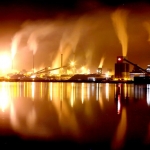Toxic Pop: How Tar Sands Fuel Disposable Cans
Driving south from Vancouver, Canada, towards Seattle, the scenery is perfectly pastoral with rolling hills and grazing cows. But suddenly, dominating the horizon, the view is interrupted by a phalanx of refinery towers shooting white-gray plumes into the sky. These industrial spires of BP's Cherry Point refinery loom high over Whatcom county, a lush border region a little more than 100 kilometers north of Seattle.
Washington State's largest refining complex provides jet fuel, gasoline and diesel to markets up and down the west coast of North America. I had driven there on a rainy morning last month, hoping to learn more about the economic alchemy that transforms crude oil from Alberta's oil sands and elsewhere into ever ubiquitous aluminum beverage cans.
Cherry Point plays a little known but critical role in the manufacture of these cans - in fact one-sixth of the world's output would not be possible without an industrial substance produced here in massive volumes each day.
Every year 100 billion soda, beer, and juice cans are cracked open by North Americans each year, almost one can for every person every day. That vast market suggests that transitioning off fossil fuels to halt climate change will be more complicated than the oft-proclaimed solution of switching to a greener forms of transportation.
From Alaska to Alberta
Inside a low brick building at the front of the BP refinery, I shook hands with Bill Kidd, BP's local director of external affairs. "How're you doing?" he exclaimed with a broad smile that made lines appear at the corners of his eyes.
The 52-year-old Kidd, dressed smartly in sleeveless black sweater, slacks and white dress shirt, led me to what passes here as a spacious corner office. Here he explained how Cherry Point is a showcase of North America's oil-boom past and its more troubled future. With the dwindling of easy oil that has gushed from the ground for the last century, the energy industry is in a full-bore search for rich, new reserves, including the oil sands of western Canada.
Built by the Atlantic Richfield Company (ARCO) in 1971 specifically to process crude oil shipped from Alaska's North Slope, Cherry Point was acquired by British Petroleum after the two companies merged in 2000. Today BP (the company dropped the original name in 2001) has become North America's largest oil and gas producer. The company generated profits of US$16.6 billion in 2010 even after a deadly explosion at its offshore Gulf of Mexico Macondo rig created the worst environmental disaster in U.S. history.
For over a decade, the massive Prudhoe Bay reserves and other frigid deposits nearby helped supply refineries on the west coast. Indeed Cherry Point still memorializes those early glory days with a four-foot tall sculpture of a flower with sheet metal petals surrounding an old Prudhoe Bay drill bit.
But production, which peaked at 2.1 million barrels per day in 1989, "has fallen off a cliff," Kidd told me. Today, daily yield has plummeted to just over 600,000 barrels.
The refinery now sources only half its oil from Alaska, with places as varied as West Africa and Russia helping make up the difference, Kidd said. Most significantly, up to 14 percent of Cherry Point's current crude supply can be traced back to Alberta's vast oil sands reserves, according to trade research conducted by the Borealis Centre for Environment and Trade Research, based on data from the U.S. Department of Energy.
"How much we use specifically is sensitive information," Kidd told me when I asked him about the figure. "But that is not an outlandish number."
From Crude to Can
About 90 percent of the crude oil that gets pumped into Cherry Point comes out as gasoline, diesel and jet fuel - the bread and butter of North America's refining industry. But the Washington state complex is unique in that it is one of the world's leading providers of a substance essential to the aluminum industry.
When transportation fuels are separated from crude oil, they leave behind a tarry residue. Break down that substance with high temperatures and pressure, and it becomes petroleum coke, a valuable industrial solid. Petcoke, as it is known, gives off intense heat when it burns, making it ideal for the production of cement, steel and certain specialty chemicals. It is also extremely carbon-intensive, releasing almost double the greenhouse emissions of natural gas.
At Cherry Point, some of this petcoke is sent via conveyor belt to the calciner, a collection of large hearths that Kidd compared to a "2,300F degree coffee roaster."
The finished product, "calcined coke," is then loaded onto tankers and shipped to aluminum smelters in Australia, Brazil, New Zealand, Canada, and South Africa, according to Borealis. Those smelters in turn outsource their metal to beverage can producers around the world.
When you follow the supply chain all the way back, "one in six aluminum cans is made using BP Cherry Point's calcinated coke," the company's website brags.
It used to be that most of the refinery's output stayed onshore, Kidd said. Only a generation ago, the U.S. aluminum industry was thriving, shipping 7.3 million tons of metal in 1973, up 21 percent from the year before.
But a booming trend towards global trade hit domestic smelters fast and hard. "Nearly all our aluminum in the next century is probably going to come from offshore countries," a spokesperson from Ferndale's smelter, only a few kilometers south of Cherry Point, lamented in 1986. The industry could not escape the same economic factors that killed off domestic steel production: relatively high labor and energy costs.
Energy Security
Tune into any discussion on the future of U.S. oil supply and you're going to hear the phrase "energy security" an awful lot. . The debate's gained even more urgency since the Paris-based International Energy Agency (IEA) announced late last year that world conventional oil production likely peaked in 2006.
Critics of continued reliance on fossil fuels argue that these dwindling conventional oil reserves mandate a switch to renewable or even nuclear power. The oil industry however is banking on a different strategy. Notably Republican legislators in the U.S., oil industry lobbyists and Canada's own prime minister, Stephen Harper, have seized onto this fear as a way to promote the oil sands business.
Cherry Point, by relying on the oil sands for up to 14 percent of its crude supply, is helping push the shift from crude oil to unconventional sources. And though the refinery isn't currently considering the pricey upgrades that would let it process even more, BP's Kidd said the prospect isn't too hard to imagine.
"This refinery was built when you had a huge pool of crude in Alaska, the biggest gasoline markets in the world in California and we were right in between. Now you're just moving the supply a little bit east," he said. "I think it's reasonable to think that more [oil sands] will come this way."
The refinery's supply-chain narrative - once mighty oil fields in decline, greater reliance on higher-carbon unconventional sources - is being replayed globally. Other North American refineries - such as BP's Whiting complex in Indiana - have invested billions of dollars to handle fast-growing shipments of oil sands crude.
The plan to bring the oil industry into line with changing conditions also includes Keystone XL, a proposed 3,200 kilometer mega-pipeline that travels south from the Canadian province of Alberta to refineries lining the Gulf coast of Texas.
Supporters such as TransCanada, the company proposing to build it, say Keystone XL would "reduce dependence on foreign oil from the Middle East and Venezuela," and thereby "improve U.S. energy security."
Toxic "Mordor"
One of the main reasons why environmental activists oppose this strategy is the impact that the extraction of oil sands have on the province of Alberta, a thousand kilometers to the north west of Cherry Point.
There are up to an estimated 2.5 trillion barrels of crude waiting to be extracted in Alberta. This makes the oil sands North America's largest single source of petroleum, far surpassing Saudi Arabia. But developing those reserves is not an easy - or pretty -- task. Each barrel of oil sands crude must either be clawed from frigid muskeg bogs with industrial-scale shovels, or melted out of underground formations with high-pressure steam and toxic chemicals.
A United Nations water advisor in 2008 compared the region's strip-mined panoramas and sprawling toxic lakes to Mordor, the fictional dark realm of Middle Earth created by J. R. R. Tolkien.
"The air is foul, the water is being drained and poisoned and giant tailing ponds line the Athabasca River," Canadian environmentalist and author Maude Barlow said at the time.
Alberta's oil sands industry also produces 23 percent more greenhouse gas emissions per barrel than more conventional operations such as those in Prudhoe Bay, a recent European Union report estimated.
The provincial government has argued that report is "unfair" because it uses out-of-date figures. And in 2009 outgoing premier Ed Stelmach told an economic forum in Geneva, Switzerland, that "no matter which extraction method is used, Alberta has some of the most stringent environmental regulations in the world."
Climate Change Threat
The other reason that critics cite in opposing the oil sand industry is global warming. Only days after I drove to Cherry Point, delegates from more than 180 countries were gathering in Bonn, Germany, for two weeks of climate talks. The mood on day one was sombre as they were confronted by an IEA report showing that greenhouse gases were at record highs, despite 20 years of attempts to control them.
"A serious setback," is how the IEA's chief economist, Fatih Birol, described the figures.
Part of the reason is that global oil consumption is not going down even though supplies of easy-to-access conventional oil, the very commodity that made a global trade in aluminum cans possible, likely peaked five years ago, as the IEA pointed out last November.
Instead the IEA expects that oil sands, oil shale and extra heavy crude - among the most greenhouse gas-intensive fuel sources on the planet - are filling the gap and are projected to make up roughly 11 percent of global supply by 2030.
This trend "risks tipping the world over the brink in terms of climate damage," according to a 2010 report by Friends of the Earth Europe.
Yet a radical shift in global efforts to fight climate change -one of the most pressing crises in human history -- seems less and less likely each year. If the world's nations can't limit the Earth's average temperature rise to two degrees above pre-industrial levels, scientists predict that everything from global agriculture to the world's coastal cities will be in peril.
Many environmentalists believe the Obama administration can make a difference by canceling TransCanada's Keystone XL proposal, a pipeline that would pump 800,000 barrels of high-carbon Alberta oil sands crude into the U.S. every day.
"The best way to build energy security in America is through clean, home-grown sources of energy that won't run out -- such as wind and solar for electric vehicles and fuel efficiency and smart growth to reduce our dependence on oil," Natural Resources Defense Council's Susan Casey-Lefkowitz wrote earlier this year.
Yet switching power and transportation sources are only part of the answer. Closing up my interview at the Cherry Point refinery, I asked Kidd how North America can possibly square its global warming goals with a fossil fuel industry so ubiquitous it's difficult to imagine life without it.
"Obviously," he replied, the smile now gone from his face, "we're going to have to do something radically different."
I asked Kidd one final question: "Could we have a global pop, beer and juice can industry without crude oil?"
"Nope," he replied. "Hydrocarbons in general are incredibly ubiquitous in our economic engine. It isn't just transportation fuel that will be the issue."
On my drive back to Vancouver I saw crude oil wherever I looked - like an invisible coating on every concrete overpass, eighteen-wheeler semi-truck and pop can discarded on the side of the road.
The question of "energy security" had never seemed so complex.
Geoff Dembicki reports extensively on the growing political influence of Alberta's oil sands industry and other climate change-related issues for TheTyee.ca, an award-winning online newspaper based in Vancouver, Canada.
- 190 Natural Resources



